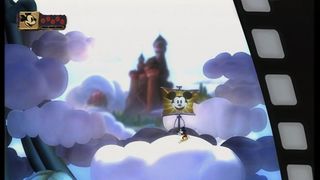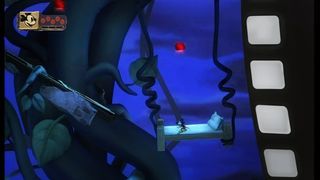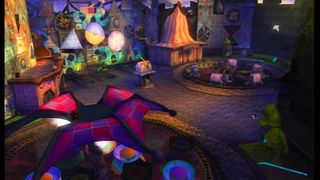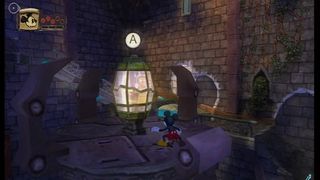Once the masters of animation and the inspiration for some solid 16-bit platformers, Disney seems to have lost it. It’s hard to think of a recent film or game from them that’s been any good. Their big-eared mascot’s most notable recent role came when he gothed it up in the Kingdom Hearts series (he also grew massive and smashed up Denver in an episode of South Park, but we doubt Disney was too happy about that).

You won’t get to do anything similarly evil in Epic Mickey, the first Disney-related title since 1994’s Mickey Mania that we’re actually excited about. Your choices are limited to being a hero, and… being a different kind of hero. But despite games luminary Warren Spector’s involvement, don’t expect Epic Mickey to go all Deus Ex.
That said, you will have to make certain choices during the course of your adventure that will affect the game’s setting – the purgatory-like Cartoon Wasteland that houses forgotten Disney characters – for better or for worse. The game’s themed around paint: you can use it to make things in the environment, or apply paint thinner to erase stuff from existence. Either way, you’ll be waving the Wii remote around as a virtual paintbrush.

Mickey ends up in the Wasteland after accidentally tipping paint into a magic mirror (we’ve all done it), unwittingly creating a nasty creature called the Phantom Blot, who proceeds to assume control of the world. Mickey gets sucked in to sort out the mess and prove there’s life in the old rodent yet. Gaze at the inky screenshots and you might assume this is a straight 3D platform game, but there are actually three types of stages in Epic Mickey. One is the traditional action sort, although its focus on painting and un-painting the environment makes it far more original than most platformers we can think of.
Out-of-reach ledge proving a nightmare to get to? Simply make a new one by lavishing gloopy paint all over the screen. Conversely, you can add thinner to remove parts of the environment, revealing previously hidden objects. But paint can be used in combat too – by drawing objects such as a clock or television, Mickey can slow down time or befuddle enemies with the awesome power of the idiot box. Obviously there’ll be limits as to where and how often you can use these abilities, the most obvious being the meter that drains every time you use the magic brush.

The second type of level lets Mickey explore settlements and run errands for NPCs. The one we saw during our hands-on demo was a cute fetch quest: buying a bunch of flowers so that a lovelorn fellow can approach the lactose-intolerant girl of his dreams (the dietary info is important as you’re given the option to buy ice cream instead, which won’t go down well as a gift).
One of the most prominent characters in the game is, ironically, probably the most obscure. Oswald the Lucky Rabbit was one of Disney’s first creations, ditched by the company after a cash dispute. If you think he’s bitter because Mickey stole his career and relegated him to the Wasteland, well, you’re bang on the money actually. Along with the Phantom Blot, he’s one of two arch-villains you’ll face during the game.

It’s a surprisingly dark plot, though we expect Goofy will turn up at some point to lighten the mood with one of his irritating chortles. While much of the chatting is done in the field, the game’s cutscenes are portrayed in the style of early Disney storyboards, making an already faithful game seem all the more authentic. However, for those of us born after WWII, it’s thankfully not all obscure mascots and in-jokes related to dated ’20s cartoons, as many of the game’s locations and characters appear to be brand new.
The third type of stage connects the other two together. To get from an action stage to a questy one, Mickey will need to traverse a side-scrolling platform level. These are based on his early animated adventures, with Steamboat Willy being the only one that’s been shown off so far. While these sections don’t seem anywhere near as sophisticated as the 3D bits – in our demo at least, the 2D platforming was beautiful but very basic – it’s always nice to see Disney’s heritage explored, rather than their more recent, factually inaccurate historical films featuring a pair of wisecracking kettles or something. The design of Mickey himself is based on the jaunty, stretchy limbed mouse you’ll see in the early cartoons, and his satisfyingly bouncy animation reflects this.

It’s about time someone made a proper Disney game, even if it does star Mickey Mouse, a character with all the personality of yogurt. What’s more important, however, is that someone other than Nintendo is making a proper, creative platformer, a genre surprisingly lacking in quality on the Wii. If all goes to plan, Mickey will be a famous gaming mascot once more, and even Oswald may achieve some notoriety at last, in his new role as villain. See, it all works out in the end.
Sep 22, 2010
If you'd like to see more articles from NGamer, you can get a subscriptionhere.
